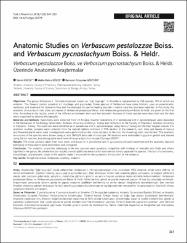Anatomic Studies on Verbascum pestalozzae Boiss. and Verbascum pycnostachyum Boiss. & Heldr
Özet
Objectives: The genus Verbascum L. (Scrophulariaceae) known as "sigir kuyrugu" in Anatolia is represented by 248 species, 193 of which are endemic. The flowers contain essential oil, mucilage, and glycosides. Some species of Verbascum have some folkloric uses as expectorants, sedatives, and treatment for dysmenorrhea and rheumatalgia. Its use for healing wounds in animal care has also been reported. In this study, the anatomic structures of root, stem, and leaves of Verbascum pestatozzae Boiss. and Verbascum pycnostachyum Boiss. & Heldr. are given for the first time. According to the results, some of the differences between stem and leaf anatomic features of these species were described and the data were supported by detailed photographs. Materials and Methods: Specimens were collected from C3 Antalya: Voucher specimens of V. pestalozzae and V. pycnostachyum were deposited in the Herbarium of the Biology Department, Akdeniz University in Antalya, Turkey and Herbarium of the Faculty of Pharmacy, Anadolu University in Eskisehir, Turkey. The materials were identified as V. pestalozzae and V. pycnostachyum using flora of Turkey and the East Aegean islands. For anatomic studies, samples were collected from the natural habitats and kept in 70% alcohol. In the research, root, stem and leaves of mature and flowered plants were used. Investigations were performed on the cross-sections of the root, the flowering stem, and the leaf. The anatomic structures of the species were drawn using a Leitz SM-LUX binocular microscope. All sections were embedded in glycerin gelatin and stained using Sartur reactive, and photographs were taken through a light microscope (Olympus BX51T). Results: The cross sections taken from root, stem, and leaves of V. pestatozzae and V. pycnostachyum were examined and the anatomic features belonging to these plants were determined and compared. Conclusion: The anatomic properties belonging to the two species were generally compatible with findings of Metcalfe and Chalk and others signified in the genus. We believe that our results provide additional evidence for taxonomists to help separate the species. The lack of a taxonomic, morphologic, and anatomic study on the species made it important for the systematic introduction of the research.
Kaynak
Turkish Journal of Pharmaceutical SciencesCilt
15Sayı
3Koleksiyonlar
- Makale Koleksiyonu [125]
- Scopus İndeksli Yayınlar Koleksiyonu [8325]
- WoS İndeksli Yayınlar Koleksiyonu [7605]


















